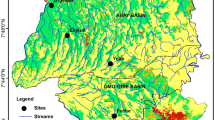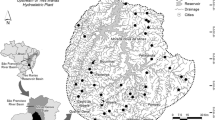Abstract
It is a fundamental tenet of Rapid Biological Assessments (RBA) that the samples collected reflect the community from which they are drawn. As with any biological sampling, RBA collections are subject to sampling error resulting in the omission of some taxa. The aim of this study is to compare the composition of RBA samples with an estimate of community structure based on extensive quantitative sampling. We used logistic regression to explore the relationships between the frequency of a taxon being collected in an RBA sample and its biological and ecological traits, namely its abundance, distribution, body size and habit. RBA samples and quantitative estimates of community structure were made in riffles in the Kangaroo and Nepean Rivers, New South Wales, Australia. Single RBA samples may collect up to 63% of the taxa that are collected by extensive quantitative sampling at a site. The frequency of a taxon being recorded in an RBA sample was significantly and positively related to all traits tested indicating a bias in the collection methods towards large, abundant and widely distributed taxa. Accordingly, taxa missed by RBA sampling were generally small, narrowly distributed or rare. These findings enhance our understanding of what RBA samples represent, and the bias and source of errors associated with RBA sampling. This study also quantifies the utility of RBA methods for biodiversity assessment.
Similar content being viewed by others
References
Bradley, D. C., & Ormerod, S. J. (2002). Evaluating the precision of kick-sampling in upland streams for assessments of long-term change: The effects of sampling effort, habitat and rarity. Archiv fur Hydrobiologie, 155, 199–221.
Cao, Y., Williams, D. D., & Larsen, D. P. (2002). Comparison of ecological communities: The problem of sample representativeness. Ecological Monographs, 72, 41–56.
Chessman, B. C. (2003). New sensitivity grades for Australian river macroinvertebrates. Marine and Freshwater Research, 54, 95–103.
Clarke, R. T., Furse, M. T., Gunn, J. M., Winder, J. M., & Wright, J. F. (2002). Sampling variation in macroinvertebrate data and implications for river quality indices. Freshwater Biology, 47, 1735–1751.
Colwell, R. K. (2000). EstimateS version 6.0b1. University of Connecticut. Retrieved December 2003 from, http://viceroy.eeb.uconn.edu/estimate.
Frost, S., Huni, A., & Kershaw, W. E. (1971). Evaluation of a kicking technique for sampling stream bottom fauna. Canadian Journal of Zoology, 49, 167–173.
Furse, M. T., Wright, J. F., Armitage, P. D., & Moss, D. (1981). An appraisal of pond-net samples for biological monitoring of lotic macroinvertebrates. Water Research, 15, 679–689.
Gaston, K. J. (2003). The structure and dynamics of geographic ranges. Oxford: Oxford University Press.
Gaston, K. J., & Kunin, W. E. (1997). Rare-common differences: An overview. In W. E. Kunin & K. J. Gaston (Eds.), The biology of rarity: Causes and consequences of rare-common differences (pp. 12–29). New York: Chapman & Hall.
Growns, J. E., Chessman, B. C., Jackson, J. E., & Ross, D. G. (1997). Rapid assessment of Australian rivers using macroinvertebrates: Cost and efficiency of 6 methods of sampling. Journal of the North American Benthological Society, 16, 682–693.
Hannaford, M. J., & Resh, V. H. (1995). Variability in macroinvertebrate rapid-bioassessment surveys and habitat assessments in a northern California stream. Journal of the North American Benthological Society, 14, 430–439.
Hart, B. T., Davies, P. E., Humphrey, C. L., Norris, R. H., Sudaryanti, S., & Trihadiningrum, Y. (2001). Application of the Australian river bioassessment system (AUSRIVAS) in the Brantas River, East Java, Indonesia. Journal of Environmental Management, 62, 93–100.
Hawkins, C. P., Norris, R. H., Hogue, J. N., & Feminella, J. W. (2000). Development and evaluation of predictive models for measuring the biological integrity of streams. Ecological Applications, 10, 1456–1477.
Hornig, C. E., & Pollard, J. E. (1978). Macroinvertebrate sampling techniques for streams in semi-arid regions. Comparison of surber and unit-effort travelling kick method. Office of Resource Development, Monitoring Support Lab. EPA 600/4-98-040. U.S. Environmental Protection Agency, Las Vegas, NV.
Hose, G., Turak, E., & Waddell, N. (2004). Reproducibility of AUSRIVAS rapid bioassessments using macroinvertebrates. Journal of the North American Benthological Society, 23, 126–139.
Hosmer, D., & Lemeshow, S. (1989). Applied logistic regression. New York: Wiley & Sons.
Hughs, B. D. (1975). A comparison of four samplers for benthic macroinvertebrates inhabiting coarse river deposits. Water Research, 9, 61–69.
Humphrey, C. L., Storey, A. W., & Thurtell, L. (2000). AUSRIVAS: Operator sample processing errors and temporal variability - implications for model sensitivity. In J. F. Wright, D. W. Sutcliffe, & M. T. Furse (Eds.), Assessing the biological quality of freshwaters: RIVPACS and other techniques (pp. 143–163). Cumbria, U.K.: Freshwater Biological Association.
Kerans, B. L., Karr, J. R., & Ahlstedt, S. A. (1992). Aquatic invertebrate assemblages: Spatial and temporal differences among sampling protocols. Journal of the North American Benthological Society, 11, 377–390.
Kohler, S. L. (1992). Competition and the structure of a benthic stream community. Ecological Monographs, 62, 165–168.
Kroger, R. L. (1972). Underestimation of standing crop by the Surber sampler. Limnology and Oceanography, 17, 475–478.
Marchant, R. (1989). A subsampler for samples of benthic invertebrates. Bulletin Australian Society of Limnology, 12, 49–52.
Marchant, R. (2002). Do rare species have any place in multivariate analysis for bioassessment? Journal of the North American Benthological Society, 21, 311–313.
Menard, S. (2002). Applied logistic regression analysis. Series: Quantitative Applications in the Social Sciences, No. 106 (2nd ed.). Thousand Oaks, CA: Sage Publications.
Merritt, R. W., & Cummins, K. W. (1996). An introduction to the aquatic insects of North America. Iowa: Kendall/Hunt Publishing.
Metzeling, L., Chessman, B., Hardwick, R., & Wong, V. (2003). Rapid assessment of rivers using macroinvertebrates: The role of experience, and comparisons with quantitative methods. Hydrobiologia, 510, 39–52.
Metzeling, L., Robinson, D., Perriss, S., & Marchant, R. (2002). Temporal persistence of benthic invertebrate communities in south-eastern Australian streams: Taxonomic resolution and implications for the use of predictive models. Marine and Freshwater Research, 53, 1223–1234.
Murray, B. R., Thrall, P. H., Gill, A. M., & Nicotra, A. B. (2002). How plant life-history and ecological traits relate to species rarity and commonness at varying spatial scales. Austral Ecology, 27, 291–310.
Nichols, S. J., & Norris, R. H. (2006). River condition assessment may depend on the sub-sampling method: Field live-sort versus laboratory sub-sampling of invertebrates for bioassessment. Hydrobiologia, 572, 195–213.
Plafkin, J. L., Barbour, M. T., Porter, K. D., Gross, S. K., & Hughes, R. M. (1989). Rapid bioassessment protocols for use in streams and rivers: Benthic Macroinvertebrates and Fish. EPA/444/4-89-001. Washington: U.S. Environmental Protection Agency.
Poff, N. L., Olden, J. D., Vieira, N. K. M., Finn, D. S., Simmons, M. P., & Kondratieff, B. C. (2006). Functional trait niches of North American lotic insects: Traits-based ecological applications in light of phylogenetic relationships. Journal of the North American Benthological Society, 25, 730–755.
R Development Core Team (2005). R: A language and environment for statistical computing. R Foundation for Statistical Computing, Vienna, Austria. Retrieved August 20 2005, from www.R-project.org.
Resh, V. H. (1979). Sampling variability and life history features: Basic considerations in the design of aquatic insect studies. Journal of the Fisheries Research Board of Canada, 36, 290–311.
Resh, V. H., Beche, L. A., & McElravy, E. P. (2005). How common are rare taxa in long-term benthic macroinvertebrate surveys? Journal of the North American Benthological Society, 24, 976–989.
Reynoldson, T. B., Rosenberg, D. M., & Resh, V. H. (2001). Comparison of models predicting invertebrate assemblages for biomonitoring in the Fraser River catchment, British Columbia. Canadian Journal of Fisheries and Aquatic Sciences, 58, 1395–1410.
Schmid, P. E., Tokeshi, M., & Schmid-Araya, J. M. (2000). Relation between population density and body size in stream communities. Science, 289, 1557–1560.
Simpson, J. C., & Norris, R. H. (2000). Biological assessment of river quality: Development of AUSRIVAS models and outputs. In J. F. Wright, D. W. Sutcliffe, & M. T. Furse (Eds.), Assessing the biological quality of freshwaters: RIVPACS and other techniques (pp. 125–142). Cumbria, U.K.: Freshwater Biological Association.
Stark, J. D. (1993). Performance of the Macroinververtebrate Community Index: Effects of sampling method, sample replication, water depth, current velocity and substratum on index values. New Zealand Journal of Marine and Freshwater Research, 27, 463–478.
Stead, T. K., Schmid-Araya, J. M., Schmid, P. E., & Hildrew, A. G. (2005). The distribution of body size in a stream community: One system, many patterns. Journal of Animal Ecology, 74, 475–487.
Storey, A. W., Edward, D. H. D., & Gazey, P. (1991). Surber and Kick sampling: A comparison for the assessment of macroinvertebrates community structure in streams of south-western Australia. Hydrobiologia, 211, 111–121.
Turak, E., Waddell, N., & Johnstone, G. (2004). Australia-wide assessment of river health: New South Wales AusRivAS sampling and processing manual. Monitoring River Heath Initiative technical report number 13. Commonwealth of Australia and New South Wales Environment Protection Authority, Canberra and Sydney, Australia. Retrieved September 10 2006, from www.deh.gov.au/water/rivers/nrhp/manual-nsw/index.html.
Wright, J. F. (2000). An introduction to RIVPACS. In J. F. Wright, D. W. Sutcliffe, & M. T. Furse (Eds.), Assessing the biological quality of freshwaters: RIVPACS and other techniques (pp. 1–24). Cumbria, U.K.: Freshwater Biological Association.
Wright, J. F., Furse, M. T., & Armitage, P. D. (1993). RIVPACS-a technique for evaluating the biological quality of rivers in the U.K. European Water Pollution Control, 3, 15–25.
Author information
Authors and Affiliations
Corresponding author
Rights and permissions
About this article
Cite this article
Gillies, C.L., Hose, G.C. & Turak, E. What do qualitative rapid assessment collections of macroinvertebrates represent? A comparison with extensive quantitative sampling. Environ Monit Assess 149, 99–112 (2009). https://doi.org/10.1007/s10661-008-0186-9
Received:
Accepted:
Published:
Issue Date:
DOI: https://doi.org/10.1007/s10661-008-0186-9




